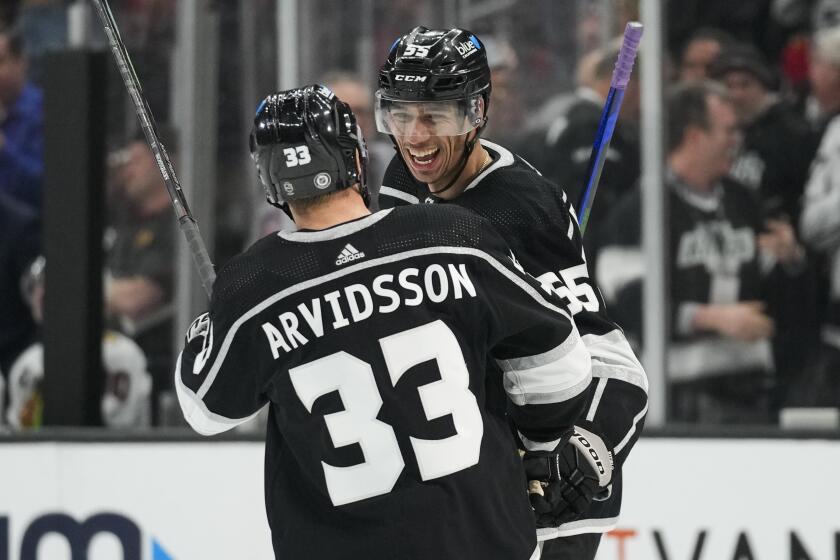Up and Down the Arroyo
* 1. A birdie hole. Tiger Woods might make his approach with a five- or six-iron, most will use four-woods and just about everybody is capable of getting home in two. There is out of bounds left and prevailing wind is right-to-left. Fred Couples once yanked two in a row out of bounds.
* 2. Probably the most difficult hole on the course because of its length and narrow fairway (30 yards). A tee shot into the rough makes it extremely difficult to reach the elevated green in two. Morning players generally get a break because the prevailing wind has yet to kick up.
* 3. The big danger is pushing the ball to the right and catching the trees, which can lead to bogey or worse. The hole plays into the prevailing wind, which can make the second shot anything from a three-iron to a nine-iron. Players who hit long face a chip from high rough to a green that slopes away.
* 4. “Just seriously long,” is Miller’s description. Some may hit driver. “I don’t care who you are, if you’re a tour pro and you hit it thin, the bunker [in front] is a serious factor,” Miller says. Most players are happy with par. Tom Watson aced this hole one year en route to a 29 on the front nine.
* 5. Not especially difficult. Players will hit a draw, get lots of roll and hit a six- or seven-iron to the green. If a player hits right on his approach, he virtually cannot get close to the pin because the pin will be on the right side of the green. Craig Stadler has called this the best driving hole on the course.
* 6. There’s a sand trap in the left-center of the green. Accuracy is not too much of a problem for a tour pro with a six- or seven-iron in his hands. “But once in a while you’ll have a situation where a guy gets in a weird place around the bunker and it can be pretty comical,” Miller says.
* 7. Most will tee off with a three-wood and play a fade, but a shot in the right rough gives the worst angle to a long, narrow green. An approach shot that misses right causes problems. “They’d rather miss the green left than right, no matter what the pin placement is,” Miller says.
* 8. The narrowest fairway on the course, 27-30 yards wide, and a bunker that requires 225 yards of carry create an interesting tee shot. Most will play three-wood, wedge. One year, Ben Hogan played a four-iron off the tee and a four-iron to the green all four days, never making worse than par.
* 9. The left fairway bunker requires about a 250-yard drive to clear. “I saw John Daly hit a sand wedge here to the green one year,” Miller says. Most players will go to the right, though. Because the green slopes severely from back to front, an accurate approach shot is essential for those hoping for birdie.
* 10. Jack Nicklaus calls this the best short par four in the world. A seductive tee shot invites a gamble. In the 1995 PGA, third-round leader Ernie Els laid up the first three days and had three birdies. On Sunday, he hit a driver and made bogey. He finished two shots behind winner Steve Elkington.
* 11. Another hole the pros say they should birdie, assuming the eucalyptus trees on the right don’t come into play. It was double-eagled in the PGA by Per-Ulrik Johansson, with a three-wood and the wind at his back from about 272 yards. Reachable in two for long hitters, a three-shot hole for others.
* 12. In 1995, eventual winner Corey Pavin was in the right rough off the tee and hit a four-wood. “He just wanted to get left of the green and try to get up and down for par, which he did,” Miller says. Dense rough and pin placement are the problems for approach shots that miss to the right.
* 13. Not a tough hole unless the wind is blowing. There is out of bounds immediately to the left of the green. In the 1995 tournament, Kenny Perry, chasing Pavin, hit a five-iron out of bounds on the last day of the tournament. He made double bogey and finished three shots behind Pavin.
* 14. Peter Jacobsen had a hole in one here in 1994. The green is huge, but it is terraced, so if players don’t hit it close they can get some tricky positions, and three-putts aren’t rare. “Generally speaking, I don’t think tournament pros look at this hole with too much concern,” Miller says.
* 15. Monstrously long. Even pros are happy with a par. The start of four good finishing holes, where tournaments are often decided. Jack Nicklaus chili-dipped two chip shots at 15 in 1978. He finished two behind winner Gil Morgan. Very tough to reach the green from the left rough.
* 16. A small green surrounded by bunkers is not particularly easy to hit, especially when the wind is blowing. Balls hit too high will get held up and fall short. Balls driven too low will go through the green. Balls landing anywhere on the green mean a short putt for birdie, so pros love this hole.
* 17. Only a few pros feel they can reach this green in two. Last year Tom Lehman reached it on the last day but three-putted. Most will hit their tee shots left-center and then hit their approaches right-center. A two-tiered green slopes to the front. Most leave approach shots just short of the hole.
* 18. A great finishing hole. The tee shot must be left center. Because of the kikuyu grass and the downhill slope to the left of the green, players are very careful with their second shots. “Missing left on 18 is disaster,” Miller says. “It’s the toughest up-and-down on the course. It’s indescribably difficult.”
More to Read
Get our high school sports newsletter
Prep Rally is devoted to the SoCal high school sports experience, bringing you scores, stories and a behind-the-scenes look at what makes prep sports so popular.
You may occasionally receive promotional content from the Los Angeles Times.






